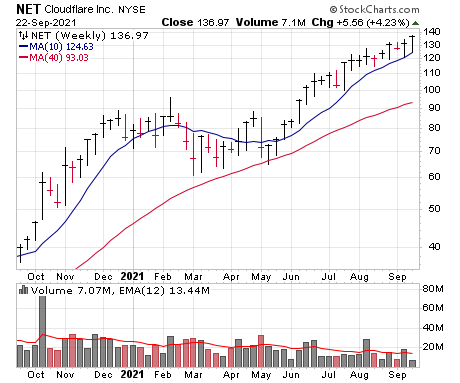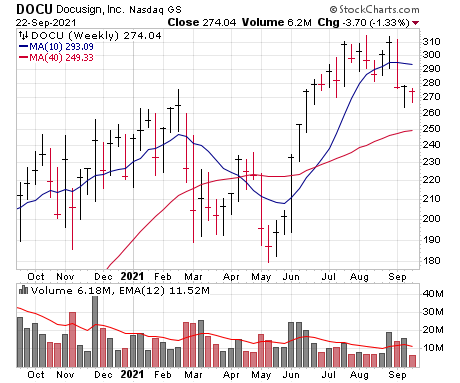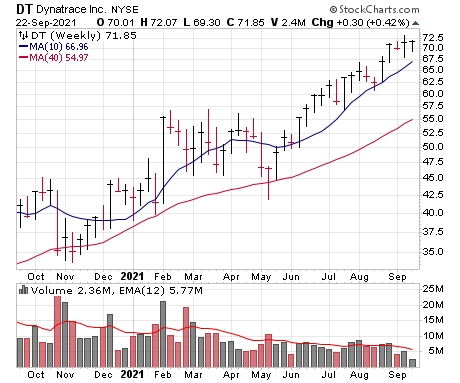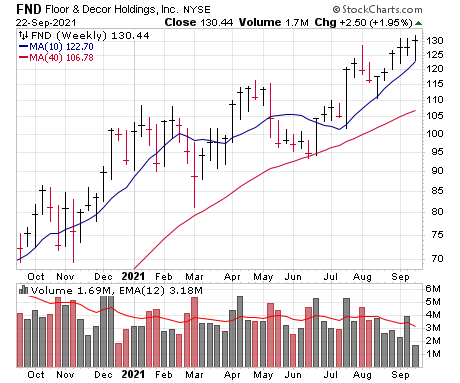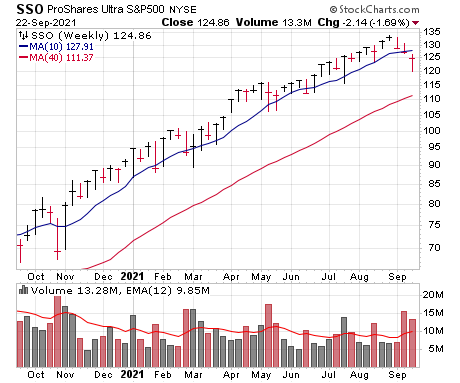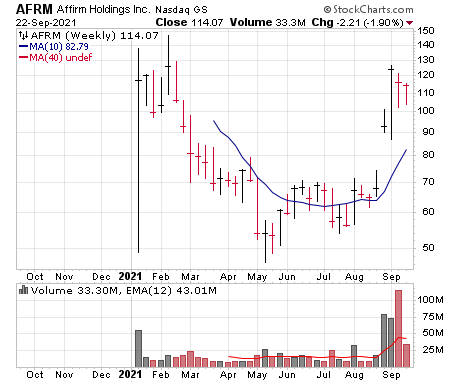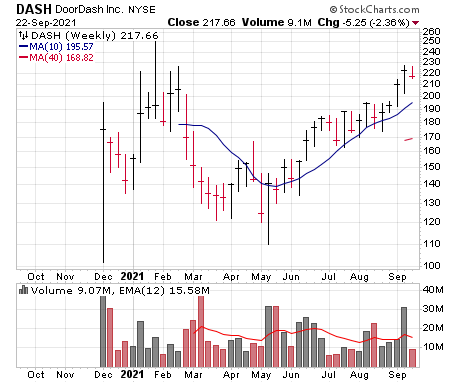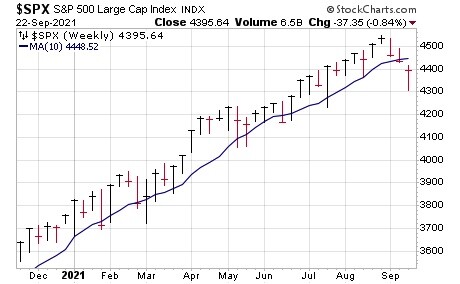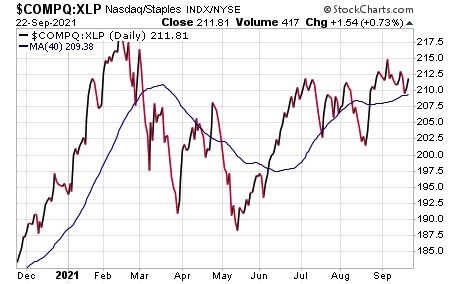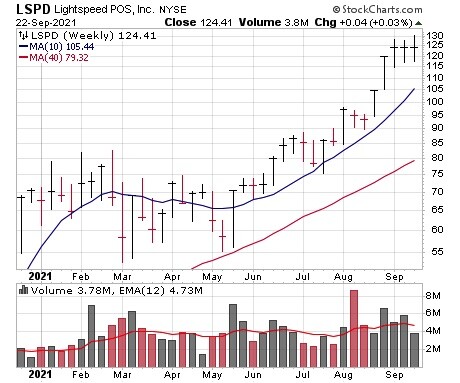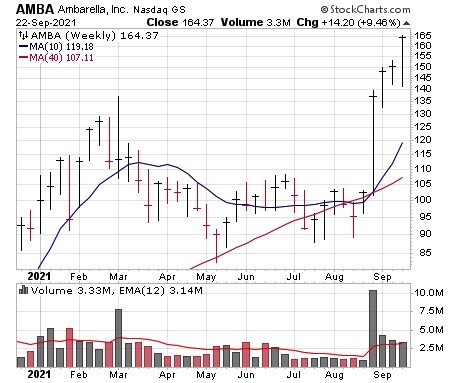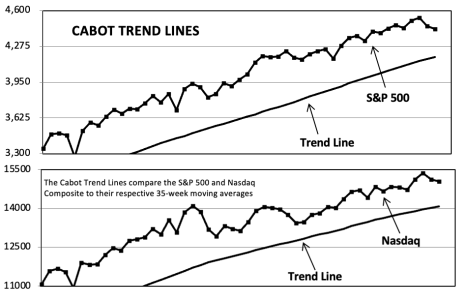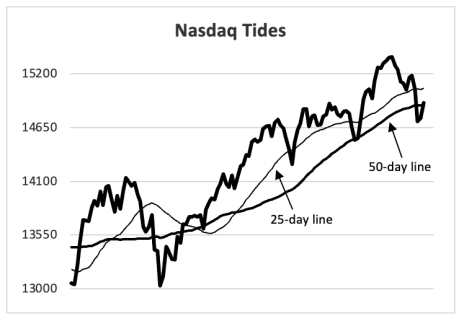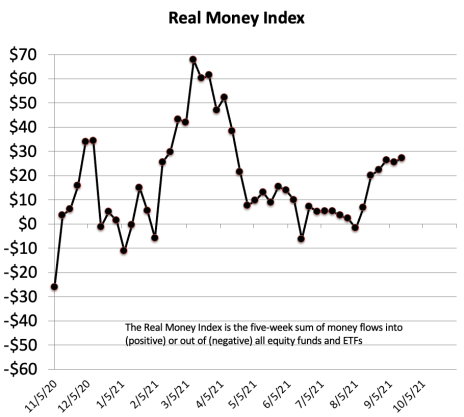The market’s weak start to September and this Monday’s decline flipped our Cabot Tides to bearish; we responded by selling half of our leveraged long fund (SSO) and holding the cash. However, even with that decline, we were encouraged to see growth stocks hold firm, and the bounce back since then has also been good to see. If this turns out to be one big shakeout, there are many names on our watch list that we’d like to start positions in, but it’s too soon to conclude that.
Tonight, we have no changes, though the next few days should be key.
Cabot Growth Investor 1481
[premium_html_toc post_id="237985"]
Market Iffy, but Growth Stocks Buoyant
Back when I started at Cabot in 1999, it was the middle of the internet bubble, which itself occurred at the tail end of what was a massive five-year run in the market. Every dip was bought, and the need for market timing was next to nothing—not surprisingly, our timing system decayed, and when the worm finally turned, we got hit by the initial phases of the bear market like everyone else.
That prompted some changes, starting with a redoubling of our focus on trend following: Our intermediate-term Cabot Tides were born in 2001 and remain largely unchanged since then, and a few years later, we revamped our long-term Cabot Trend Lines to keep up with the times. Because of how they work, these two trend models are guaranteed to keep us on the right side of their respective trends.
Thus, when we see the Cabot Tides crack this week for the first time in months, it’s not a signal we take lightly—especially considering the prolonged run the big-cap area of the market has enjoyed, with the S&P 500 avoiding any serious selling for the past 10 months! You could argue that the rally since then has returned the indicator to neutral territory, but overall, the facts tell us that the market as a whole has turned even more iffy, which argues for a cautious stance.
However, it’s also important to look at all the evidence, and there, the picture looks more sanguine: The aforementioned Cabot Trend Lines (our most reliable indicator) are still solidly bullish, and most encouragingly, growth stocks have held firm, etching higher lows even during Monday’s selloff—with some snapping back to new highs yesterday and today! (We write more about this developing relative strength later in this issue.) Indeed, 2021 has been much more about individual stocks and sectors rather than the Dow or S&P 500, which haven’t come close to telling the whole story of what’s going on this year; we’re keying off that even more than the indexes.
That’s no reason to ignore the Tides or the breakdown in a few major indexes—we came into the week with a decent chunk of cash already, and sold half of our leveraged long fund when the Tides broke support.
What To Do Now
But, while we’re far from complacent, the resilient action of growth stocks (including many we own) and the snapback in some indexes has us standing pat with the rest of our names. In the Model Portfolio, we’re holding around 36% in cash after selling half of SSO, but we’re holding on tightly to our best performers (indeed, many still have Buy ratings) and we’re not opposed to adding exposure if the early-week decline turns into one big shakeout.
Model Portfolio Update
There have been yellow flags of various kinds for months, with divergences, rotation and crosscurrents the norm, and yet for the big-cap indexes, the sellers really couldn’t decisively take control. But they certainly stepped up early this week, with fears surrounding Chinese real estate causing a decisive breakdown on Monday.
Of course, we were hardly flooring the accelerator of late given the iffy evidence, coming into the week with just over 30% in cash, and we hiked that a bit by selling half of our (large) position in our leveraged long index fund. That said, the difference between this market decline and that in the spring is that growth stocks are resisting far better.
Thus, we’re still taking things on a stock-by-stock basis. We have one problem child right now (DOCU), but we’re giving it a bit more rope, and we’re holding on to our other names, many of which actually tagged new high ground today. Lastly, our watch list has a few names we wouldn’t mind taking a swing at if the market and growth stocks continue to firm up.
Current Recommendations
| Stock | No. of Shares | Portfolio Weightings | Price Bought | Date Bought | Price on 9/23/21 | Profit | Rating |
| Asana (ASAN) | 1,354 | 8% | 73 | 7/22/21 | 124 | 72% | Buy a Half |
| Cloudflare (NET) | 1,790 | 11% | 113 | 6/25/21 | 136 | 20% | Buy |
| Devon Energy (DVN) | 7,240 | 10% | 28 | 5/7/21 | 33 | 17% | Buy |
| DocuSign (DOCU) | 682 | 9% | 291 | 6/25/21 | 274 | -6% | Hold |
| Dynatrace (DT) | 3,114 | 10% | 65 | 8/6/21 | 74 | 13% | Buy |
| Floor & Décor (FND) | 1,845 | 11% | 111 | 4/9/21 | 130 | 17% | Buy |
| ProShares Ultra S&P 500 (SSO) | 871 | 5% | 60 | 5/29/20 | 128 | 113% | Hold |
| CASH | 774,285 | 36% |
Asana (ASAN)—ASAN continues to impress in a big, big way—shares finally hit some turbulence on Tuesday, falling as much as eight points, but it’s snapped right back to its highs the next day. Even with that drop, there was nothing close to a red flag here; the stock’s 10-week line is way down around 88, and after the recent moonshot, some sort of rest or pullback is certainly allowed. We’ve gotten a few questions about whether or not to take some profits given the big advance, and our general response is: If you have a “full sized” position (whatever that means to you), we’re not opposed to shaving off some (less than half) of your shares and trailing a stop on the rest. (Think of it as having your cake and eating it too.) But for our part, we “only” have a half-sized stake and, given the newness of the move—the stock’s initial breakout came in June, so all else equal, ASAN’s overall advance should still be in the early innings—and the fact that many work management software peers are acting well (though Asana definitely looks like the leader), we’re simply sitting tight, though we’re comfortable waiting for a well-defined entry point to average up, especially given the tricky market environment. If you’ve been following along with us, hang on, and if you’re still looking to get in, aim for dips of a few points to start a small position. BUY A HALF
Cloudflare (NET)—We’re not sure Cloudflare will ever be a household name, but it’s effectively positioning itself as one of the core pieces of infrastructure for the Internet as a whole—whether it’s speeding up websites and apps, protecting them from a variety of hacking and denial-of-service attempts no matter where they are (public or private cloud, SaaS applications, IoT devices, etc.) or providing an easy-to-use platform for developers, Cloudflare’s network and ever-growing list of offerings is already used by more than 126,000 customers with plenty of upside ahead, especially among big enterprises. As for the stock, it’s been jerked around here and there, but sellers haven’t been able to gain a foothold, with each test of the 25-day line (including one on Monday) bringing in the buyers; indeed, shares actually tagged new high ground yesterday, which is obviously good to see. Further wobbles are possible (even likely) if the market has another leg down, but there’s no question that NET is a leader and the path of least resistance remains up. We’ll stay on Buy, though given the environment, aim to enter on dips. BUY
Devon Energy (DVN)—While oil prices and stocks have been tossed around by news-driven moves, the facts look better than the fears that have periodically pop up: As we approach the end of Q3, we see that oil prices have averaged around $70 per barrel during the quarter, which is actually up from $66-ish in Q2, and when you combine that with much higher natural gas prices (Devon’s base case was $3.50; but gas has averaged north $4 this quarter) and fewer hedges, it’s a good bet that Devon’s already beefy dividends (49 cents per share will be paid September 30) should get even larger in Q3 and beyond, all while it’s able to pay down more debt and stockpile extra cash. After a sharp dip on Monday with the market, DVN has come storming back to new highs on solid volume, making it two straight weeks the stock has found solid buying support. It’s a good bet that volatility will remain high, but we continue to have the the view that the stock’s sterling cash flow story, 15-week correction and (today) solid breakout has set the stage for a new advance. We’ll stay on Buy, but be prepared for plenty of ups and downs. BUY
DocuSign (DOCU)—DOCU corrected 16% from high to low, which certainly wasn’t pleasant, but in our view wasn’t abnormal either given the June/July advance and the tricky market environment. The key is what happens from here—if shares can generally hold above their recent lows (give or take), we’re happy to hang on given the huge consolidation that began last September and the still-strong growth story that should play out for a long time to come. (Indeed, analysts have moved up their 2022 estimates of late, now looking for 31% earnings growth, which is very likely conservative.) If you’re craving cash in your portfolio, we’re not going to argue shaving off a few shares of the stock here, as it is our worst performer. But beyond that, we think it’s best to grit your teeth and see how the stock reacts now that it’s had a pullback. Hold for now. HOLD
Dynatrace (DT)—Whereas most stocks have been extremely volatile, we remain impressed with DT’s relatively cool, calm and collected action; that doesn’t guarantee good things, of course, but generally speaking that’s a sign that the stock is “under control” of big investors. And why shouldn’t it be? The company continues to lead the way and think big when it comes to its future: At its Investor Day last September, management was targeting 15% to 20% growth in new customers each year (at the time it had penetrated less than 20% of the Global 15,000), with a 20%-ish same-customer revenue growth rate, resulting in a 25% annual growth in annualized recurring revenue (and a 30%-plus growth in free cash flow), leading to a many-fold increase in business over time. And that says nothing about the lengthening contracts moving to two-year from one-year deals in general), which adds to the rapid, reliable growth story. We’ll stay on Buy. BUY
Floor & Décor (FND)—There have been some worries that sky-high prices and a general lack of inventory (just 2.6 months of supply!) will crimp the housing market, but some forward-looking indicators (especially mortgage activity and building permits) point to continued healthy demand, and some company-specific measures (like traffic to Floor & Décor’s website) also point to strength—and likely making the forecasts for flat-ish growth for this company in the second half of this year (due to tough comparisons) much too low. Whatever the reason, FND continues to act well, with a brief shake to its 25-day line (and 10-week line) during Monday’s mayhem leading to a solid rebound back to its prior highs. Similar to a lot of names we see, it looks like this stock wants to get going following many months of ups and downs … but the overall market will have a lot to do with it. We’re sticking with our Buy rating, but given the environment, new buyers should aim for dips of a few points. BUY
ProShares Ultra S&P 500 Fund (SSO)—The November-to-September uptrend is one for the record books, as the S&P 500 tested its 50-day line eight separate times and advanced as much as 1,050 points before finally cracking the intermediate-term uptrend earlier this week. As we wrote about a few times, such a crack would likely prompt us to trim our SSO position (which moves twice the S&P 500 every day, up or down), and we did just. that on our special bulletin Monday afternoon, selling half our shares and taking a good profit off the table. Given our thought that this bull market is still intact (the rebound since Monday helps the cause), we’re happy to give the rest of our stake some room to maneuver, but it’s also true that such breakdowns like we saw this week usually (not always) lead to some further reverberations. Throw in the fact that our Cabot Tides are still negative, and Hold is the appropriate rating. HOLD
Watch List
- Ambarella (AMBA 169): AMBA remains super strong, booming to new highs yesterday. We’re not chasing it here, but we do think a new advance is underway. See more later in this issue.
- Dexcom (DXCM 573): DXCM isn’t the fastest horse, but it looks fine, trending higher above its 25-day line. The new G7 CGM, set to be released later this year, should drive a new, multi-year growth wave.
- LightSpeed (LSPD 124): LSPD is probably the top name on our watch list—we think it has new leader written all over it. The stock has refused to come in (yet), though we think it’s next pullback should be buyable. See more later in this issue.
- Snap (SNAP 79): It’s hard to find a choppier stock than SNAP, but shares have been well controlled for two months (between 70 and 80) and the top brass is on record looking for 50% annual sales growth for the next few years.
- Wingstop (WING 183): WING appears to be in the process of gradually breaking free of a year-long rest as the firm’s continued great results entice new buyers.
- ZoomInfo (ZI 69): We’re still pretty full on software names, but if we weren’t, ZI could be next up—it looks like a follow-on opportunity in the sales software space.
Other Stocks of Interest
Affirm Holdings (AFRM 127)—We’ll be frank here, we’re not huge fans of the “buy now, pay later” movement that’s gaining traction, as it entices some people that maybe can’t afford something to effectively take out a short-term loan (pay it back over a few months, albeit with interest in most cases) … which they may have trouble repaying. Still, there’s no question the tactic is catching on, as many don’t mind paying a few extra bucks on a $100 or $200 purchase as long as it’s spread out over a few months. And, to be fair, the method is transparent (no hidden fees, flexible payment options that are chosen, never pay more than what’s agreed to), which is a plus. The leader in this new category looks to be Affirm Holdings, which partners with various retailers, including Best Buy, Shopify, Adidas, Nike, Peloton, Expedia and others, to offer customers seamless payment options when they’re checking out online, and it’s been a hit: In Q2, gross merchandise volume rose 106%, revenues lifted 71% and active users (7.1 million) and merchants (29 million) grew massively. Perception-wise, though, it was the firm’s latest deal that got investors’ attention: Affirm has partnered (non-exclusively) with Amazon, allowing buyers to split up purchases of $50 or more, which obviously could be gargantuan for Affirm. There are some moving parts here (the company will often securitize its loans), and bad debt expense is real (5.8% allowance for credit losses), which will hurt if/when the economy really runs into trouble. But big picture there’s little doubt the future is bright—in its latest quarterly report, management guided for gross merchandise volume growth of 60% in the next 12 months, and that excludes any benefit from the Amazon partnership. As for the stock, it’s been crazy, with a huge post-IPO collapse, some meandering in the 55 to 70 area, and then a jaw-dropping move (both on the Amazon news and on Q2 results) back to 126 before chopping around a bit. We’re not chasing it here, but the power is impressive and a bit more seasoning could set up an entry point.
DoorDash (DASH 217)—The pandemic has changed many things, and one of the simplest ones is the dramatic increase in delivery services—two years ago, deliveries were reserved for stuff bought from Amazon or clothes from Gap, and maybe for the occasional pizza, but today, groceries, prescriptions, all types of takeout (even marijuana!) and more are being shuttled to people’s homes (or businesses) with regularity. Uber (via Uber Eats) is a play on this trend, but that company’s exposure to ride sharing muddies the story. DoorDash, on the other hand, is a pure play on the delivery movement, claiming to be the leader in terms of customer base: Even as the pandemic eases, revenues soared 83% in Q2 from a year ago, while total orders lifted 69% (to 345 million!) and, while earnings are in the red, EBITDA was solidly in the black (up 43% to about 33 cents per share). Possibly most important, DoorDash is gaining share and its clients are staying active (order frequency actually picked up sequentially in Q2), thanks in part to more orders from non-restaurants; the company added over 5,000 new convenience stores to its marketplace in the quarter, added Albertson’s to its grocery offering and added PetSmart to its pet supply deliveries. Throw in some expansion overseas (it now operates in Canada, Australia and Japan) and this week’s announcement of alcohol delivery services (!) and we think business can continue to surprise on the upside even as the world gradually turns right side up. That’s one of the big ideas here—while the triple-digit growth of 2020 isn’t likely to be repeated, next year’s estimate of just 19% revenue growth seems very conservative. Big investors seem to think so: After topping in February and having a fierce post-IPO dip (57%!), shares have marched higher in recent months back to their old highs. Chances are DASH will need some time to consolidate up here, but it’s a name we’re watching—a big breakout (possibly in a few weeks after its quarterly report?) could be tempting.
Zscaler (ZS 280)—Maybe we’re biased, but nobody is going to convince us that the broad cybersecurity area won’t grow many-fold in the years ahead—as more important and sensitive information is stored online and in the cloud, more sophisticated hacking methods will be employed for either profit or national advantage. Zscaler has long been one of our favorite new-age outfits in the space, with a solution built from the ground up for the way the world actually works these days: Instead of a corporate network with a data center or two needing to be protected (and if one person connecting to it is infected, it all gets infected), today, the Internet is effectively the network, as users need to access apps and everything else from all over the place. (In the words of Zscaler’s CEO, the apps have left the castle that everyone was building a moat around.) Zscaler does just that, connecting users to apps and systems, not entire networks, while also making the apps invisible to the outside (can’t be hacked) and implementing all privileges and policies for user access that each client wants. And it’s branching out a bit, too, with new products to monitor the digital experiences of end users and offering cloud workload protections, too. The technology minutiae can give you an ice cream headache, but the basic idea is easy to understand, and it’s been a hit among the firm’s target client base, which is those with north of 2,000 employees—it was an upstart just three years ago, but Zscaler has already signed up one-quarter of the Forbes Global 2000 and has 26 million licensed seats, but just to show you how big the opportunity is, the company has a big-picture goal of 200 million seats down the road. Revenue growth has been at 50%-plus for many quarters, and the forward-looking metrics (deferred revenue and billings both up 70%-plus last quarter) have been even better. ZS had a great comeback starting in May and accelerated to new price and relative performance highs in August before settling back after earnings. A bit more rest is likely, but we think the next big move is up.
Is Growth Finally Retaking the Leadership Baton?
The big event of the week was the intermediate-term breakdown of the big-cap indexes—with our Cabot Tides turning negative for the first time in a while, it’s best to think more about capital preservation than making money, especially given the fact that the S&P 500 hasn’t seen any extended selling pressures for 10 months.
However, there is one distinct difference between this downdraft and the few others we’ve seen so far this year: Growth stocks as a whole are slowly developing relative strength. Obviously if the major indexes truly nosedive, all bets are off, but there’s been a gradual change in character when looking at growth vs. the rest of the market.
First, to compare, take a look at the daily charts of the S&P 500 and the Ark Innovation Fund (ARKK) from back in the spring—while the S&P 500 was making higher lows in early March, late March and again in May, ARKK (and other growth-oriented indexes and funds) were sinking to lower lows (or at best, retesting the same low).
Now, though, you can see that while the S&P 500 dove below support and its August lows, ARKK has not; it’s not super strong, but you wouldn’t know there was a mini-panic of late in the market looking at the recent action.
Beyond just the S&P is how growth is doing compared to the cyclical leaders of earlier this year; if you compare the performance of the Ark Fund to the SPDR Industrials Fund (XLI) or something like the iShares Transports (IYT), you’ll again see that growth and glamour names are holding well above their prior lows on a relative basis.
Finally, there’s our favorite relative strength indicator of all—Cabot’s Aggression Index, which simply looks at the action of the growth-oriented Nasdaq to the defensive-minded Consumer Staples Fund (XLP). Again, you’d think if the Chinese real estate sector is going to cause a calamity then the Nasdaq would plunge and money would pour into the XLP. There’s been a smidge of that lately, but not much; the Aggression Index also remains well above prior lows and above its 40-week moving average, which keeps the measure in bullish territory.
None of this means the Cabot Tides or our other key market timing indicators don’t count anymore—they do, and if the recent rebound falters, there’s real risk we’ll see further breakdowns. That said, 2021 has been mostly about rotation, and after a few months of poor action and a few more months of repairing the damage, we may be seeing the start of growth stocks retaking the leadership baton—if it holds, it should lead to great opportunities during the next advance.
Follow the Volume
One side effect of the choppy environment this year is that it’s been difficult to identify which stocks are truly under strong accumulation, compared to those that are just being pulled up by some rotation—in other words, it’s been hard to conclude which moves will lead to further strength vs. which rallies will keel over.
Still, the one chart factor that continues to prove its mettle is volume—big-volume buying is still the best (and relatively easy) thing to look for to tell you a stock’s upmove is the real deal. Obviously, there are qualifications—a few days (or weeks!) of big volume is better than just one day, and it’s best if the buying power shows up after a rest period. If you see those, though, you likely have a stock that can head higher in the intermediate term.
Indeed, right now, two of our top watch list stocks have shown this action. The first is Lightspeed (LSPD), which we wrote about a month ago; it acts and quacks like another Shopify of sorts, this one targeted to the hospitality and retail industries. It broke out from its first-ever base in early July and, after some initial hesitation, recently went vertical on three straight weeks of heavy volume. If LSPD can pull in toward some moving averages, we might take a small position as long as the market isn’t imploding.
The other name, which is more of a zinger, is Ambarella (AMBA), which looks to us like a new glamour leader in the chip space. As we wrote about last issue, the firm’s four-year investment spree has led to new and unique computer vision chips; as millions of new autos have a ton more cameras and as millions of legacy security cameras are upgraded to smart cameras, demand could explode for at least a couple of years. The stock’s liftoff on earnings was something else (17x average volume!) and it’s actually piled on more big gains this week. We’re not chasing it here but something special seems to be happening, so it’s worth monitoring.
Cabot Market Timing Indicators
The big-cap indexes decisively broke down this week, turning our Cabot Tides negative, though growth stocks didn’t crack and the rally since then has been good to see. It’s possible the news-driven move was one big shakeout, but (a) we need to see more to conclude that and (b) usually these selling waves have more than one leg. Right now, it’s best to practice some caution but to continue holding your strong names.
Cabot Trend Lines: Bullish
Our most reliable indicator is the Cabot Trend Lines, and it remains clearly bullish—even after the selling this week, the S&P 500 is about 6% above its 35-week line, while the Nasdaq still stands nearly 7% above its own trend line. Thus, the longer-term trend remains up (as it has since June 2020) and the odds continue to favor the next big move being up.
Cabot Tides: Bearish
Our Cabot Tides, on the other hand, gave up the ghost for the first time in a while, turning negative on Monday’s big selloff. Encouragingly, the major indexes have snapped back nicely, with the Nasdaq Composite (shown here) the best looking of the bunch, rallying back above its own 50-day line. You could argue the intermediate-term trend is back to neutral, but after the severe break, we want to see more; right here, the Tides remain negative, though the next few days will be key.
Cabot Real Money Index: Negative
While some sentiment measures (mostly surveys) have backed off, investors haven’t been retreating with their actual portfolios—our Real Money Index shows that investors had gotten a bit jubilant in recent weeks, which is a negative for this contrary measure. Let’s see if this week’s action cools things off.
Charts courtesy of StockCharts.com
The next Cabot Growth Investor issue will be published on October 7, 2021.
Cabot Wealth Network
Publishing independent investment advice since 1970.
President & CEO: Ed Coburn
Chief Investment Strategist: Timothy Lutts
Cabot Heritage Corporation, doing business as Cabot Wealth Network
176 North Street, PO Box 2049, Salem, MA 01970 USA
800-326-8826 | support@cabotwealth.com | CabotWealth.com
Copyright © 2021. All rights reserved. Copying or electronic transmission of this information without permission is a violation of copyright law. For the protection of our subscribers, copyright violations will result in immediate termination of all subscriptions without refund. Disclosures: Cabot Wealth Network exists to serve you, our readers. We derive 100% of our revenue, or close to it, from selling subscriptions to our publications. Neither Cabot Wealth Network nor our employees are compensated in any way by the companies whose stocks we recommend or providers of associated financial services. Employees of Cabot Wealth Network may own some of the stocks recommended by our advisory services. Disclaimer: Sources of information are believed to be reliable but they are not guaranteed to be complete or error-free. Recommendations, opinions or suggestions are given with the understanding that subscribers acting on information assume all risks involved. Buy/Sell Recommendations: are made in regular issues, updates, or alerts by email and on the private subscriber website.
Subscribers agree to adhere to all terms and conditions which can be found on CabotWealth.com and are subject to change. Violations will result in termination of all subscriptions without refund in addition to any civil and criminal penalties available under the law.


